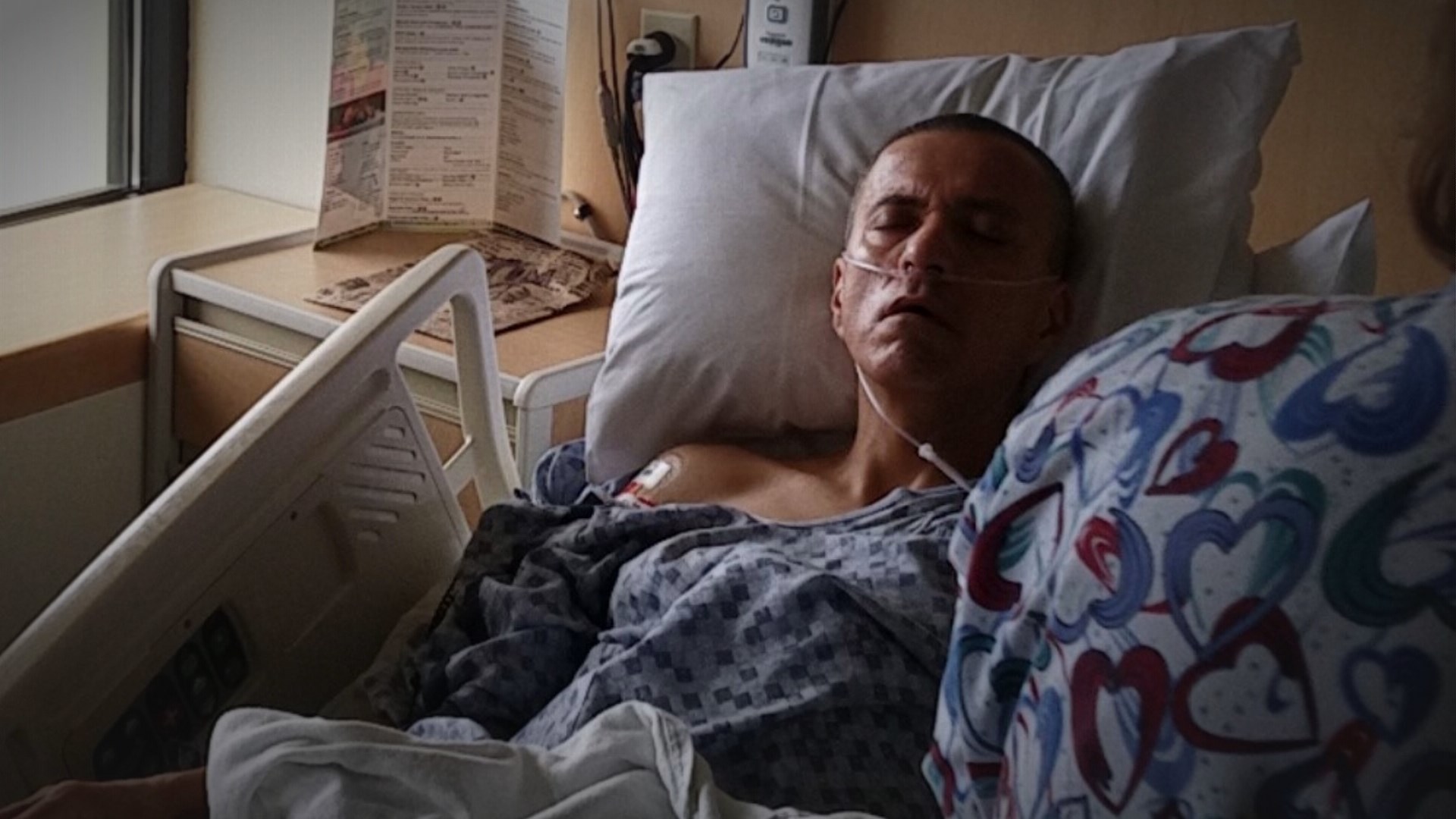Tim Combs of Bremerton lost 100 pounds in a matter of months, underwent three major surgeries in two years and had two-thirds of his stomach removed to treat gastric ulcer disease. He also suffers from depression, anxiety, dizziness, severe tooth loss and decay, headache, and stomach pain.
Combs' doctors said his health issues are the result of being exposed to toxins such as cyanide gas for seven years at the Puget Sound Naval Shipyard (PSNS).
"I've been to the bottom," said Combs, 52. "I know I didn't want to die, but I really didn't know if I was going to make it."
In a six-month investigation, the KING 5 Investigators have found that, despite warnings, PSNS managers opened and operated an unsafe wastewater treatment facility on the site from 2006 to 2013, and in the process, violated several state and federal laws meant to keep employees protected.
The violations over the seven-year period were many, including:
* Cyanide alarms were not maintained and at times were turned off.
*Ventilation systems were inadequate to protect health.
* Workers weren't trained on hazards.
* Ongoing training wasn't provided to supervisors.
* Respirators weren't issued for workers who would be exposed to airborne toxins.
* Respiratory protection program was not maintained.
* Severity of hazards were not identified.
* Workers were exposed to toxic gasses above legal limits.
Combs, who takes dozens of medications and requires regular IV infusions to keep his blood counts stable, worked in the plant as a technician for the entire seven years.
"It ruined my life," said Combs. "I was misled by my employers that this was a state-of-the-art place."
Shipyard representatives disagreed with the KING 5 analysis.
"The facility is and has always been safe," said J.C. Mathews, PSNS deputy public affairs officer. "Employee well-being is at the top of the PSNS ... priorities. (The plant) was a state-of-the-art facility when it opened in 2006."
The shipyard's work overhauling and decommissioning ships and submarines creates multiple hazardous waste streams that must be treated before discharge into the environment. The hazards include cyanide contaminated water, the known carcinogen hexavalent chromium, acids, chlorine, PCBs, lead, mercury, and other heavy metals.
Multiple sources said the plant's systems didn't work properly from the beginning. But with thousands of gallons of hazardous waste to treat every week, processing continued, often with the use of dangerous workarounds.
Alarms turned off
Cyanide alarms installed to warn employees when the deadly chemical reached unsafe levels didn't operate properly. They repeatedly sounded at odd times. Shipyard firefighters responded to the alarms, but the majority of the time did not unsafe levels of chemicals.
"The fire department (responded so often) they told (the shipyard) they were going to shut the building down," said veteran wastewater treatment plant operator Kevin Albert, who has been diagnosed with occupational respiratory disease.
Documents reviewed by KING 5 showed that managers decided to call these "false alarms." Instead of getting to the root of the problem their fix was to disable the alarms during certain processes.
"That was part of our job. We were told to turn the alarm off," said Combs. "It seemed suspicious at the time but you really can't question it. (I asked myself) ‘What is setting off the alarm then?' There's got to be something out there."
"I have terminated people for (disabling alarms)," said industrial engineering expert Dirk Dunning of Salem, Ore. "Turning off alarms endangers life safety and that's just an absolute. You don't do that."
A PSNS public affairs specialist said the alarms were only turned off during a process where no cyanide would be generated.
"Cyanide wastewater treatment is the only process accomplished at (the facility) with the potential to generate cyanide gas. It is the only process requiring the alarms to be active, and the alarm was not disarmed during the cyanide wastewater treatment process," wrote Mathews.
But an email written by a supervisor in 2013 showed the cyanide alarm, when turned on, was at times alerting employees to a different danger: sulfur dioxide.
"Our normal process was to disable the cyanide alarms when transferring (a toxic solution known as fish glue). This material set off the cyanide alarm during transfers and was tested by (a shipyard environmental specialist) for cyanide and none was found. It was deemed to be an interference chemical that set off that alarm (sulfur)," wrote supervisor Pete Laurie in an email to a top manager on November 25, 2013.
According to the EPA, "Short-term exposures to sulfur dioxide can harm the human respiratory system and make breathing difficult."
Respirators discouraged
The Navy closed the plant in 2013 and made $2 million in upgrades over the following two years, steps taken after thorough testing confirmed that levels of toxins in breathing spaces exceeded legal limits. But for years before the temporary shutdown, multiple sources said the use of respiratory protection was discouraged. And at one point, the Navy didn't maintain employee certifications to wear respirators whatsoever.
"I was told, like, ‘Why do you need a respirator?'" said Combs.
Current and former shipyard workers said supervisors frowned on wearing respirators because it would "look bad" to other employees walking by.
"They didn't want people walking by and seeing that," said Combs.
"They didn't want the perception for anybody walking past the building that would see us doing things, to have the (feeling) that we were maybe doing something dangerous," said Albert.
A spokesperson for the Navy said respirators were not required at the PSNS.
"In fact, PSNS…personnel are not permitted to work in environments requiring the use of (full respirators.) Because of this, there is no requirement for PSNS ... personnel to acquire or maintain (respiratory protection) qualifications," said Mathews.
In 2013 federal regulators from the U.S. Occupational Safety and Health Administration (OSHA) investigated the plant. They cited the lack of management's understanding of the respiratory hazards and failure to provide appropriate respiratory protection as a "serious" violation of federal regulations.
"In (the treatment facility), during cyanide destruction process, chlorine gas was emitted in levels above the (legal limits)…and the employer had not evaluated this respiratory hazard and (had not) issued appropriate respiratory protection," wrote OSHA area director David J. Baker.
The Navy continues to maintain that toxins were never a health hazard inside the treatment plant.
"We believe no member of our team has been exposed to chemicals above (unsafe) limits," wrote Mathews. "It is worth noting that PSNS falls under the guidelines of OSHA's maritime standard…for permissible exposure limits. (And due to) the applicable (scientific calculation of exposure) we have no reason to believe that the (limit) was exceeded."
KING 5 obtained Combs' personal air monitoring sample results from testing that occurred between April and June of 2013. The records show he was exposed to harmful chlorine gas on multiple occasions during a five-day period. On April 10, 2013, shipyard monitoring experts measured chlorine gas in the breathing zone where Combs was working at more than twice the amount considered immediately harmful or deadly to humans.
"I just want to say to (the PSNS managers), ‘I hope you realize you're dealing with people's lives. This isn't a chess game. There are consequences for your mistakes and the consequences are someone's life,'" said Josh Combs, age 17. Josh has been a caretaker for his dad, who is a single father, since the age of 15.
Dangerous shortcuts
In addition to alarms not in working order, the building's ventilation system didn't operate properly. "The ventilation system was not adequate to remove the chlorine from the breathing zone," wrote Navy investigators in 2013. Neither did a system designed to automatically inject hazardous chemicals into pipes and tanks. When that automated system failed, an internal Navy investigation found employees utilized dangerous workarounds involving chemicals added by hand.
"(During) cyanide (treatment)...the plant's oxidation reduction potential (ORP) and pH probes were not working. Instead, personnel used hand-held equipment tank-side to measure ORP and pH. The result was that the chemicals were added by manual operation…reducing the operator's ability to effectively control the…off gassing (of toxins)," wrote PSNS internal investigators.
Another workaround involved treating waste contaminated with the lethal chemical hexavalent chromium. When automated systems stopped working, several workers said they treated the chromium by standing over an open holding tank and dropping in bags of another toxic chemical -- sodium bisulfate. Without respirators, the workers said their strategy was to hold their breath, drop in the powdery agent, then run down the stairs to safety.
"The fumes and crap would be so thick and heavy, where you would almost be gagging. So the trick was to go up and hold your breath and (say), ‘Okay, now!'" said Combs. "You would hold your breath for up to 30 to 45 seconds while you pour, seal, then run back down the steps…That's what we did."
"In hindsight, the things that we did were horrible and as a supervisor, I continue to (remember) things that I look back and it gives me nightmares," said Albert.
According to the chemical manufacturer's Material Safety Data Sheet, sodium bisulfite in "large amounts may cause nausea, gastrointestinal upset and abdominal pain. May cause central nervous system depression, nausea and vomiting, diarrhea, violent colic and death."
The plant was finally shut down in 2013 after Kevin Albert was promoted to shop supervisor. He said his failing health and chronic problems at the plant led him to demand that experts come in to thoroughly test the air during routine work hours. Between April 5, 2013, and April 10, 2013, the testing measured unsafe levels of toxins on several occasions. Employees had to evacuate the building five times during the five days of testing.
Albert and another former manager confirm to KING 5 that thorough testing of this nature had not taken place since 2007.
Despite his ill health, Combs still works at PSNS in the Injured Worker Program. His current duties keep him away from exposure to chemicals.
“My job now is completely different. My managers go to bat for me. They are very fair and work with me on getting to all of my medical appointments. They back me up,” said Combs.
The father of four said he hopes to one day again be well enough to spend quality time with his kids. Through tears he said the loss of that time has been the worst part of being sick.
"I can't put that in words," he said. "It's big, very big. You can only be a dad once."
Follow Susannah Frame on Twitter @SFrameK5


